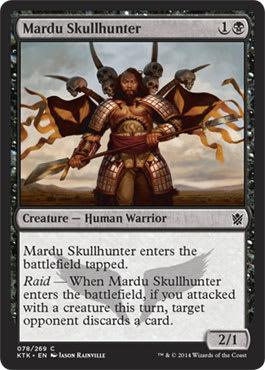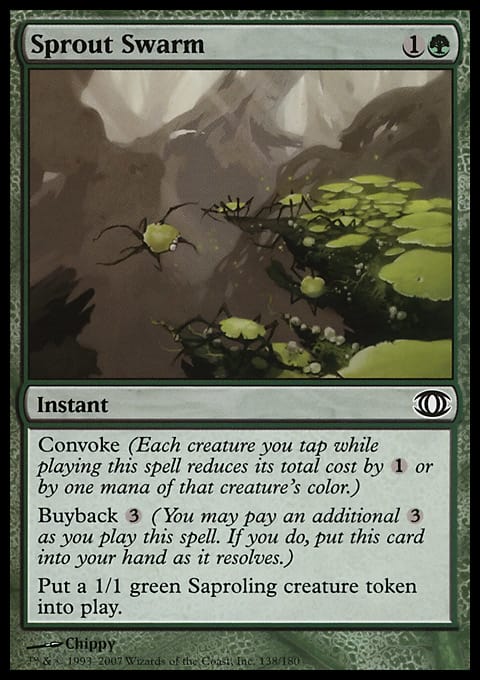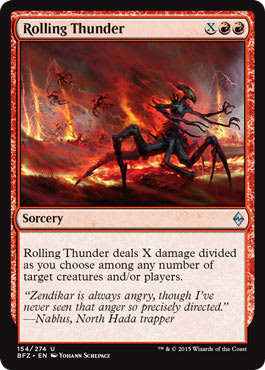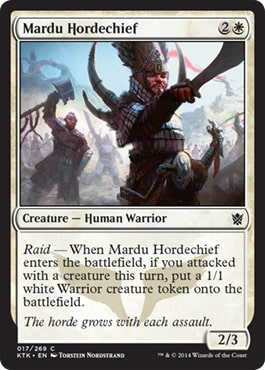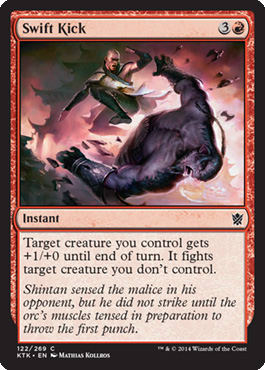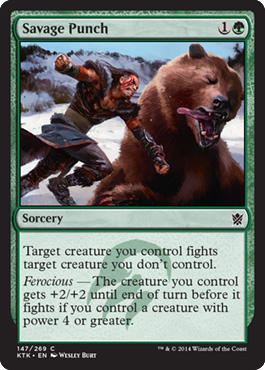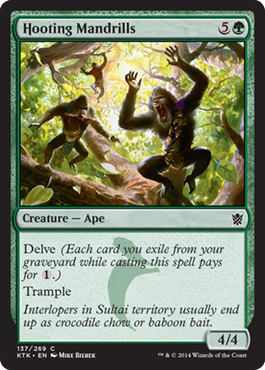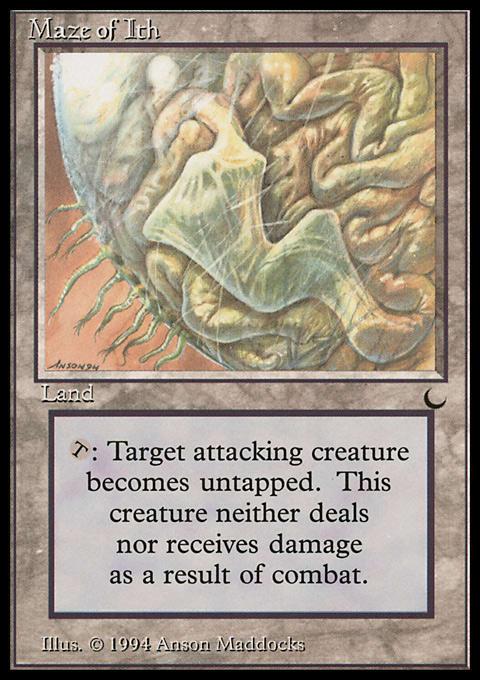If you missed previous Pauper Cube updates, here are the last nine:
- Gatecrash Pauper Cube Update
- Dragon's Maze Pauper Cube Update
- Modern Masters Pauper Cube Update
- Magic 2014 Pauper Cube Update
- Theros Pauper Cube Update
- Born of the Gods Pauper Cube Update
- Journey into Nyx Pauper Cube Update
- Conspiracy and Vintage Masters Pauper Cube Update
- Magic 2015 Pauper Cube Update
With the Change Log tab, you can see what’s been in and out of the Cube recently. If you’re unsure what’s going on with my Cube, or if want to understand how it’s evolved, I suggest going back before moving forward. This update is big, but it makes sense given the direction of the last year of updates.
Before diving into Khans of Tarkir, I want to talk briefly about my Cube design philosophy. When I started my Cube, it was a jumble of multicolored commons before Conflux and Alara Reborn released. Better known for his art and Cube maintenance, there’s one skill Eric Klug has that doesn’t receive enough talk: He’s a damn good player. While he was happy to paint a few cards for me, it was his ability to play better that drove the first major shift in the Cube.
It turned from a pile of “fun” cards into a slim, three-hundred-sixty-count box of the most powerful commons. When I took this version of the Cube to Pro Tour Philadelphia in 2011, I had the privilege to share it with a few folks in R&D. Aaron Forsythe’s option, like most of his opinions on everything, was a pithy quip: “These are just all the cards we should never have printed at common.”
My Cube echoed the “classic” Cube goal of being just the most powerful cards available. It felt good, and players found it exciting. Over the next few years, I nudged colors and archetypes to work synergistically, though it often came at the price of individual card power in a vacuum.
Through repeated feedback from folks within and outside of R&D, the Cube has evolved past its most-powerful-cards roots. Sprout Swarm and Rolling Thunder are powerful, but they’re also terrible for gameplay. The simple fact is that the best Magic designs are those that are both exciting to play and answerable when facing them as an opponent.
I came to the realization that my goal with the Cube had shifted: I cared more about the best possible play experience than about including the absolute highest power level of cards.
That’s part of this update. Several cards in the Cube do not lend themselves to interesting experiences. Thanks in part to what Khans of Tarkir brings to the table, softer power-level adjustments and smoothing will be applied, too. The end goal is to encourage the best possible play experience for players while supporting a diversity of Draft approaches:
- Like forcing a color? Mono-colored decks exist, and they are viable.
- Want to tap into synergy? Every color pair has its champion cards and theme to use.
- Like mana fixing first? Multicolored lands and the Rampant Growth clan are available for you.
That’s the high-level shift baked in now. However, I want to make it clear that powerful cards still matter and are actively sought for inclusion. One of the interesting questions from PAX this year came from Sam Stoddard: “Did you know Maze of Ith was printed on the common sheet?”
The oldest Magic sets have strange rarities, and some of those rarities aren’t always obvious from The Gatherer. The fact is that rarity is a bit more challenging since the rule is clear, but looking up the information isn’t:
@AndreasPischner @maro254 @samstod @the_stybs Official policy is commonality = what sheet it's printed on. Quantities on 1 sheet irrelevant.
— Matt Tabak (@TabakRules) September 1, 2014
There are some interesting shifts in rarity when printing counts became involved. For example, is a common printed just once on the common sheet a common or an uncommon? I’m not sure how these questions were handled when the data was loaded for Gatherer, but I do know that there are some interesting options when looking over old sets’ official print guides in comparison:
Each of those links to a site that’s no longer updated but that carries the handiest list of cards by print rarity I could find. The fact that some powerful cards are oppressive doesn’t mean other, less oppressive options can’t excite players.
All of this is before we even get into Khans of Tarkir. If you’re ready to see all of this come to, let’s get started.
White
Ainok Bond-Kin
Let’s talk outlast: It’s not very exciting to me. If you’re in a stalemate situation and can afford to take a creature or more off blocking duty (for potentially more than one turn!), outlast really shines. However, just as how level up played out in my Cube, the density of fast and efficient removal from sets long past overwhelms the power potential that sorcery-speed upgrading can provide.
But there are always exceptions: Halimar Wavewatch is a great example that the sorcery-speed drawback can be overcome. The difference between level up and outlast, however, comes down to just ![]() . Removing the option to block is a big deal, and level up’s lack thereof is what lets Wavewatch perform.
. Removing the option to block is a big deal, and level up’s lack thereof is what lets Wavewatch perform.
Ainok Bond-Kin is a great example of how close outlast can come though: A 2-drop that’s a 2/1 is sufficiently sized for the Cube, and being able to beef it up into a 3/2 (or bigger) with first strike is a real threat. Spending ![]()
![]()
![]() and an extra turn to do it makes Daru Lancer look all the better.
and an extra turn to do it makes Daru Lancer look all the better.
Army of Allah
In the last update, I added Righteous Charge, but I was overlooking one card in my search for Trumpet Blast effects in white: Army of Allah. This poorly named and insensitive card from Arabian Nights costs the same, but it is really just Trumpet Blast for white. Instant-speed pumping lets these effects work well on the offense: “Oops! You didn’t block my 1/1s!”
This brings all Trumpet Blast effects in line as instants, and it reaffirms R/W’s token theme.
Feat of Resistance
Granting protection from a color is, generally, a good trick. Cards like Stave Off, Gods Willing, and Apostle's Blessing are great pickups for aggressive decks, and they serve as de facto counterspells for most removal. Feat of Resistance is along these lines, though it costs as much as Shelter without the card-draw bonus and instead leaves a +1/+1 counter behind.
In a slight power adjustment, Feat of Resistance will replace Apostle's Blessing. This means there is no “colorless” way to get the effect—you need white—and it makes it cost slightly more, as it typically does already in white decks that cast it. The +1/+1 counter means a smaller creature can kill a larger one in combat—or the last ditch effort to kill your best threat just got worse for the opponent.
Mardu Hordechief
Do you like Attended Knight? Would you like to play a second copy? I’m a fan of redundancy to help build solid synergies in my Cube, and Mardu Hordechief plays a good second fiddle to Attended Knight. While raid can be tricky given some circumstances, the ability to lay down a virtual 3/4 for
A quick aside about raid: It’s an awesome mechanic for my Cube. Attacking is something red, white, and black can do well, so raid on these cards feels natural and rewarding. Raid is, as the cool kids say, legit.
Mardu Hordechief replaces Veteran Swordsmith, which was a nominal addition to fill in as a solid 3-drop with synergy. Making dudes is better than a narrow power pump for a tribal theme that doesn’t have the support you’d expect.
Jeskai Student
If W/U were more controlling in my Cube, this card might make the cut. A 1/3 body for just ![]()
![]() is fairly efficient, but turning every combat trick into a potential blowout thanks to prowess means attacking into it is more dangerous than it should be. Solid against aggressive decks, I’m not sure this outshines more straightforward attackers in the tempo deck my Cube presents.
is fairly efficient, but turning every combat trick into a potential blowout thanks to prowess means attacking into it is more dangerous than it should be. Solid against aggressive decks, I’m not sure this outshines more straightforward attackers in the tempo deck my Cube presents.
Mardu Hateblade
Compare Mardu Hateblade to Dutiful Thrull. (Both cards should be considered W/B for sure.) In my Cube, too much removal comes with the old-school clause stating, “It can’t be regenerated.” If you use the Thrull in your Cube, I’d consider Hateblade instead—serving as an unexciting but tricky impression of Typhoid Rats for the W/B deck isn’t a bad consideration.
Blue
No Changes
I’m still happy with blue, but I did give control decks nice treats in colorless this update.
Force Away
Unlike the sorcery-speed Void Snare in Magic 2015, the Khans of Tarkir version of the common creature bounce spell plays like Voyage's End from Theros. The bonus looting—draw a card, then discard a card—here comes on a rider asking, “Do you control a creature with 4 or more power?” And controlling such a creature is a much taller order in an environment not designed around the ferocious mechanic. This is another flavor of bounce I have on deck if the right day ever comes.
Jeskai Windscout
Prowess is an interesting mechanic, particularly for decks that like to load up with noncreatures spells: U/B control, U/R burn, and G/U ramp. While a static option with more power is my preference, Jeskai Windscout opens up some combo-like opportunities to make good tricks great in other Cubes.
Mystic of the Hidden Way
Morph is a nice mechanic for Cubes, particularly when there’s enough to give players pause. “What could it be?” is a tough question to answer when there’s enough to go around. There currently isn’t enough in my Cube, but Mystic of the Hidden Way is a close consideration: Bringing an unblockable 3-power creature in play for just ![]()
![]() wouldn’t be bad if I had a few more morphs to go along with it.
wouldn’t be bad if I had a few more morphs to go along with it.
Singing Bell Strike
Blue removal is a premium feature, and Singing Bell Strike is a fine way to lock a creature away until the late game. While it isn’t permanent and it isn’t effective on expensive creatures that dominate single-handed, as a tempo alternative to yet another bounce spell, it’s as good as it gets.
Whirlwind Adept
Whirlwind Adept is common and has hexproof. It’s an obnoxious combination, and it’s a solid way to boost Bant hexproof as an archetype. I’m not interested in exploring that option further at the moment.
Black
Mardu Skullhunter
Get. In. My. Cube. This guy is sweet. Seeing it at work throughout the Khans of Tarkir Limited I’ve played confirmed my suspicions about it upfront. Coming into play tapped isn’t that bad of a drawback when you’re probably not planning to block anyway. As a card that gets picked up by Driver of the Dead and unearth, having the ability to pick an opponent’s hand apart in conjunction with Liliana's Specter is real.
While Syphon Life was meant to give control decks a way to pad their life totals and make endless use of Pestilence or Evincar's Justice, it’s just a marginal card without an effect on the board, and it’s never made a main deck. I think the Skullhunter will.
Disowned Ancestor
Disowned Ancestor is a card I’m very close to finding room for. Stopping all but the biggest fatties cold is great, and the fact it’s black with 4 toughness puts it off-limits for a significant portion of the removal in the Cube. Control decks usually want answers, and an answer that can become a threat is why Halimar Wavewatch is so good. In my Cube, it would serve a similar purpose to Butcher Ghoul, and if you want to duplicate its ability to slow down aggro, this is a good place to start.
Sultai Scavenger
Paying 5 mana to make a 3/3 with flying is a fair benchmark for the Cube. Blue has one way to do it for 4 mana (Phantom Monster), and Sultai Scavenger is as good as that—or better. There’s almost always something in the graveyard to exile, thanks to how fragile black creatures usually are and how plentiful black removal is.
Sultai Scavenger is similar to Skirge Familiar, only with the upside of coming down for even less the later the game goes. For a U/B deck leaning on removal and counterspells, playing just ![]() for a 3/3 with flying isn’t an unreasonable dream.
for a 3/3 with flying isn’t an unreasonable dream.
Red
Mardu Warshrieker (versus Coal Stoker)
One of the questions I’ve received when I’ve begun talking about Mardu Warshrieker for my Cube has been pretty obvious: Why no love for Coal Stoker? Paying ![]()
![]() to make a 3/3 and gain
to make a 3/3 and gain ![]()
![]()
![]() back is fine, and I’ve seen Cubes that love what a turn-four Coal Stoker into Arc Lightning can do. However, making
back is fine, and I’ve seen Cubes that love what a turn-four Coal Stoker into Arc Lightning can do. However, making ![]()
![]()
![]() is a very different tale: It encourages the same types of red spells—there’s only one red common that possibly wants
is a very different tale: It encourages the same types of red spells—there’s only one red common that possibly wants ![]()
![]()
![]() , and that’s Skitter of Lizards kicked twice—but layers in two of its most common allied colors for aggro.
, and that’s Skitter of Lizards kicked twice—but layers in two of its most common allied colors for aggro.
It isn’t entirely balanced for other color pairs, but it’s exciting enough for me to give it a try. Cutting Rolling Thunder made room for it.
Swift Kick and Fall of the Hammer
I liked Fall of the Hammer when I first met it in Born of the Gods. But with plentiful removal, it just didn’t make sense at the time. Cutting Fireball makes room for a new spell, so I decided to call up Fall of the Hammer from the bench to see how it goes. Serving a very different role both as an instant and as power-based damage means R/G decks have a great tool, as do R/W decks running first strike creatures. I’m excited to see where it turns up.
Swift Kick adds an additional ![]() to the cost for the benefit of pumping your guy, but it makes the creatures fight outright instead. If you really wanted two red fight effects, you could find it with Swift Kick, but Fall of the Hammer takes the cake for me.
to the cost for the benefit of pumping your guy, but it makes the creatures fight outright instead. If you really wanted two red fight effects, you could find it with Swift Kick, but Fall of the Hammer takes the cake for me.
Valley Dasher
Spending 2 mana for a 2/2 with haste sounds like exactly what a red deck would want. However, Valley Dasher comes with the gravest of riders: Valley Dasher attacks each turn if able. I’ve tried out a few creatures with these riders over the years, and the only one that’s made it all the way is Ulamog's Crusher.
I’ll let that speak for itself.
Bloodfire Mentor
Bloodfire Mentor could fill a valuable role for U/R decks in my Cube: Its 5 toughness stops most attackers cold, and being able to filter cards is a surefire way to pull ahead. Frostburn Weird is proof that an early defensive creature is valuable—the fact that the Weird can trade up with a few fatties makes it truly shine. I’m not confident filtering alone is enough to justify a virtual Wall.
Green
Savage Punch
Bashing bears never felt so good. Savage Punch is another green removal card, serving as an effective double for Prey Upon. Here, by cutting Sprout Swarm, our work finding room for it was made easy.
Hooting Mandrills
I’m coming close to revisiting how B/G plays out and whether its toolbox can be expanded with a different theme. Currently, the self-mill/graveyard-value decks that keep making their ways into recent sets isn’t in my Cube. But because of all the recent sets with it, the commons available for black and green set up the potential for such a deck well. Hooting Mandrills is just one example of a creature that looks super-efficient in a deck led by Satyr Wayfinder, Sakura-Tribe Elder, Necromancer's Assistant, Mulch, and Grisly Salvage.
Dragonscale Boon
I was super-impressed by Dragonscale Boon all throughout my time with it. While my Cube doesn’t have any real synergy with throwing +1/+1 counters around, +2/+2 is usually a big enough difference to make untapping an easy way to eat an attacker unexpectedly. I’m not sure 4 mana is worth it, but I feel it’s a good alternative for fitting more green removal in a Cube.
Multicolored and Artifact
No changes
There isn’t much for artifacts at common in Khans of Tarkir, and the only multicolored commons are the wedge-colored morphs. Alex Ullman’s article on his Pauper Cube covers what’s going on with morph at common and why it isn’t terribly exciting for Cubes this trip around.
Land
Let me cut to a quick chart that’s important for those wondering about Khans of Tarkir foils:
This is a significant power-level change that’s in line with my goal of leveling the Cube experience. The bounce lands are very good lands. Each is typically counted as an extra half of a land in mana bases, and all of them work well to generate extraordinary value for a player. These lands, in conjunction with the Signet cycle, defined mana that was too good for the format: You could play four- and five-colored decks, relying on using your most powerful cards rather than on building thoughtful synergy from smaller pieces.
The Signets alone, when they were in my Cube, crushed green mana-ramping out of being relevant.
When there’s a skill differential between players in my Cube, it becomes abundantly clear: Skillful players grab the bounce lands earlier and more often, setting up three-or-more-colored decks that abuse the most powerful cards they find along the way. Against a two-colored deck with less focus and savvy, there’s often little the less powerful deck can do to find a win.
Swapping these lands for a de facto second cycle of the Guildgates won’t put those with more skill down on a lower level, but it will make a more colorful mana base less powerful. Three-colored value decks won’t go away, and I’m happy with that, but they won’t be as easy to play without the bounce lands to underpin them, and they shouldn’t find it as easy to trounce decks following a traditional archetype.
Strip Mine, Maze of Ith, and Mishra's Factory
There’s no doubt these lands are exciting and powerful: Two are staples in Legacy, and one is only legal in Commander and as a restricted card in Vintage. Thanks to some encouragement and a quirk of official rarity via printed rarity sheet, all of these cards have at least one version on the common sheet. While Fireball, Rolling Thunder, and Sprout Swarm can all dominate a game without much resource, these three lands are exciting yet limited:
- Strip Mine can punish both greedy multicolored decks and opening hands with little mana, but it’s a one-shot effect without any recursion available.
- Maze of Ith is a colorless answer for almost any creature, but it gives pseudo-vigilance to it as a tradeoff. It’s also an answer to just one creature: Like Leonin Bola, it can be overwhelmed by multiple threats.
- Mishra's Factory is a boon to aggressive decks that want to increase their threat density, but without multiples, Wrath of God, or Mutavault to play along, it exists as just a 2/2.
I think players will find these powerful lands exciting to use and more forgiving to fight than the three spells I’ve already cut. Making room for these lands is a little cleanup work: I’ve cut Radiant Fountain, Drifting Meadow, Remote Isle, Polluted Mire, Smoldering Crater, and Slippery Karst. Without bounce lands, and with little play even with the bounce lands around, there’s no reason to keep these lands in the mix.
Summary
This update included a lot of cards that changed over—and a lot of power that shifted downward. While I’ve tried my best to explain why I chose this path, I’m looking forward to your comments and thoughts on what I may have missed or overlooked.
We’ll check back in when Fate Reforged gets its due!
















